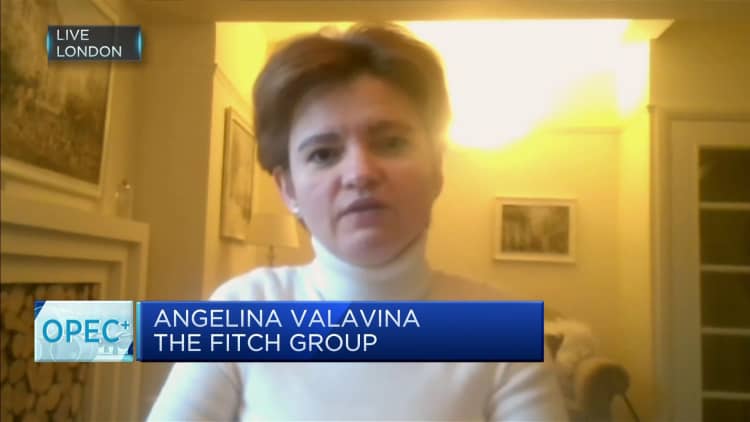A trader works on the floor of the New York Stock Exchange (NYSE) in New York City, August 29, 2022.
Brendan McDermid | Reuters
After a cumulative year for financial markets, Standard Chartered outlined a number of potential surprises for 2023 that it says are being “underpriced” by the market.
Eric Robertson, the bank’s head of research and chief strategist, said outsized market moves are likely to continue next year, even if risks decline and sentiment improves. He warned investors to prepare for “another year of shaken nerves and rattled brains.”
The biggest surprise of all, according to Robertson, would be a return to “more benign economic and financial-market conditions,” with consensus pointing to a global recession and further turbulence across asset classes next year.
As such, he named eight potential market surprises that have a “non-zero probability” of occurring in 2023, which fall “materially outside of the market consensus” or the bank’s own baseline view, but are “underpriced by the market.”
Collapsed oil prices
Oil prices surged over the first half of 2022 as a result of persistent supply blockages and Russia’s invasion of Ukraine, and have remained volatile throughout the remainder of the year. They declined 35% between June 14 and Nov. 28, with output cuts from OPEC+ and hopes for an economic resurgence in China preventing the slide from accelerating further.

However, Robertson suggested that a deeper-than-expected global recession, including a delayed Chinese recovery on the back of an unexpected surge in Covid-19 cases, could lead to a “significant collapse in oil demand” across even previously resilient economies in 2023 .
Should a resolution of the Russia-Ukraine conflict occur, this would remove the “war-related risk premium” — the additional rate of return investors can expect to take more risk — from oil, causing prices to lose around 50% of their value in the first half of 2023, according to Robertson’s list of “potential surprises.”
“With oil prices falling quickly, Russia is unable to fund its military activities beyond Q1-2023 and agrees to a ceasefire. Although peace negotiations are protracted, the end of the war causes the risk premium that had supported energy prices to disappear completely,” Robertson speculated.
“Risk related to military conflict had helped to keep front contract prices elevated relative to deferred contracts, but the decline in risk premium and the end of the war see the oil curve invert in Q1-2023.”
In this potential scenario, the collapse in oil prices would take international benchmark Brent crude from its current level of around $79 per barrel to just $40 per barrel, its lowest point since the peak of the pandemic.
Fed cuts by 200 basis points
The main central bank story of 2022 was the US Federal Reserve’s underestimation of rising prices, and Chairman Jerome Powell’s mea culpa that inflation was not, in fact, “transitory.”
The Fed has subsequently hiked its short-term borrowing rate from a target range of 0.25%-0.5% at the start of the year to 3.75%-4% in November, with a further increase expected at its December meeting. The market is pricing an eventual peak of around 5%.

Robertson said a potential risk for next year is that the Federal Open Market Committee now underestimates the economic damage inflicted by 2023’s massive interest rate hikes.
Should the US economy fall into a deep recession in the first half of the year, the central bank may be forced to cut rates by up to 200 basis points, according to Robertson’s list of “potential surprises.”
“The narrative in 2023 quickly shifts as the cracks in the foundation spread from the most highly leveraged sectors of the economy to even the most stable,” he added.
“The message from the FOMC also shifts rapidly from the need to keep monetary conditions restrictive for an extended period to the need to provide liquidity to avoid a major hard landing.”
Tech stocks fall even further
Growth-oriented technology stocks took a hammering over the course of 2022 as the steep rise in interest rates increased the cost of capital.
But Standard Chartered says the sector could have even further to fall in 2023.
the Nasdaq 100 closed Monday down more than 29% since the start of the year, though a 15% rally between Oct. 13 and Dec. 1 on the back of softening inflation prints helped cushion the annual losses.
On his list of potential surprises for 2023, Robertson said the index could slide another 50% to 6,000.
“The technology sector broadly continues to suffer in 2023, weighed down by plunging demand for hardware, software and semiconductors,” he speculated.
“Further, rising financing costs and shrinking liquidity lead to a collapse in funding for private companies, prompting further significant valuation cuts across the sector, as well as a wave of job losses.”

Next-generation tech companies could then see a surge in bankruptcies in 2023, shrinking the market cap share of these companies on the S&P 500 from 29.5% at its peak to 20% by the end of the year, according to Robertson.
“The dominance of the tech sector in the S&P 500 drags the broader equity index too,” he suggested, adding: “The tech sector leads a global equity collapse.”